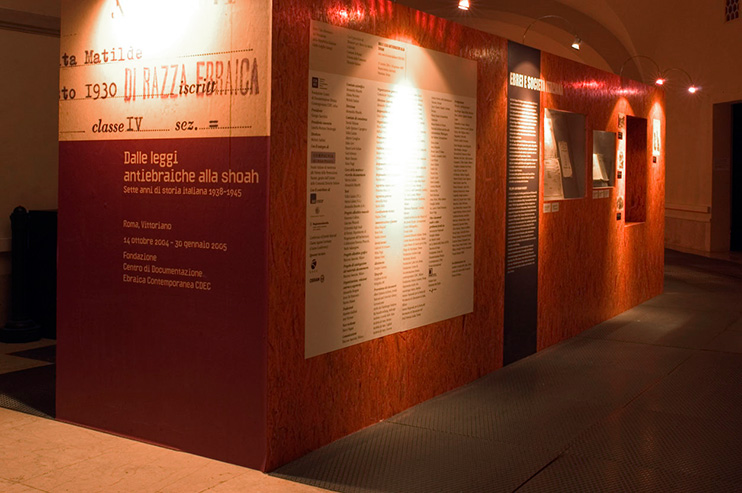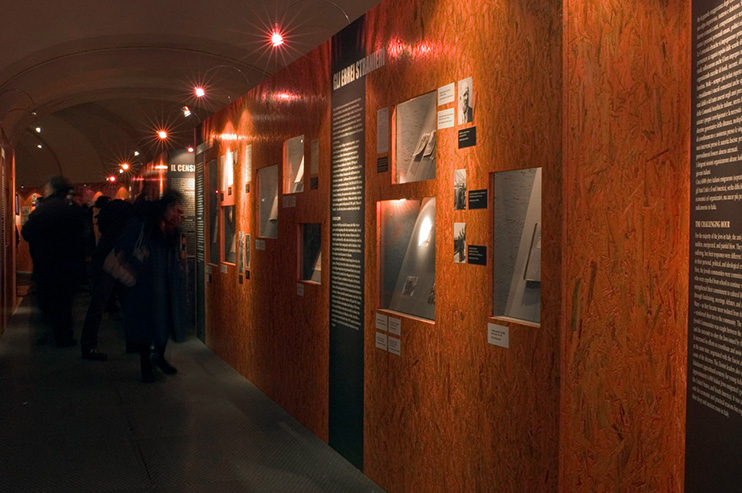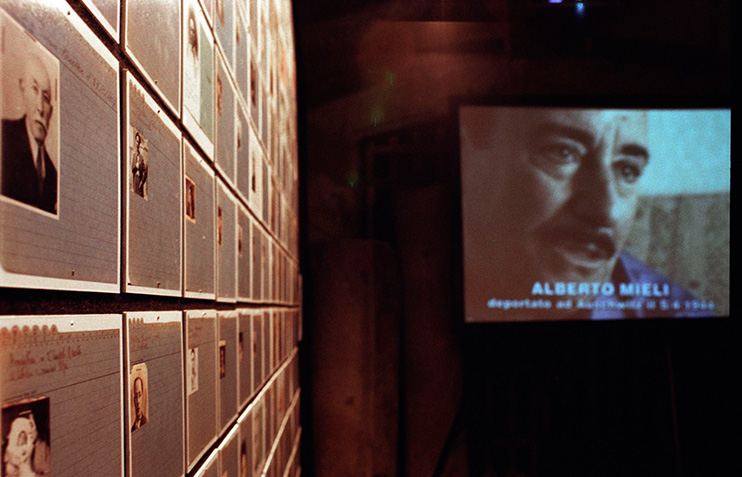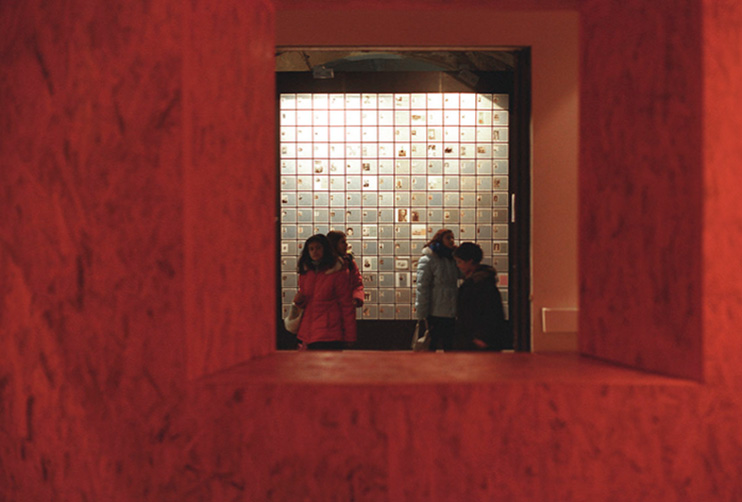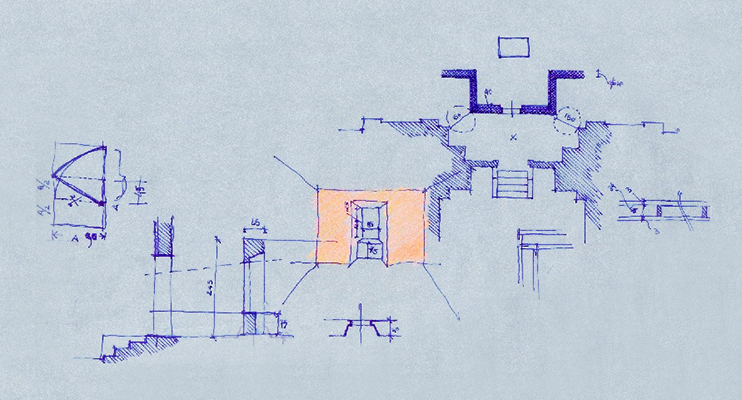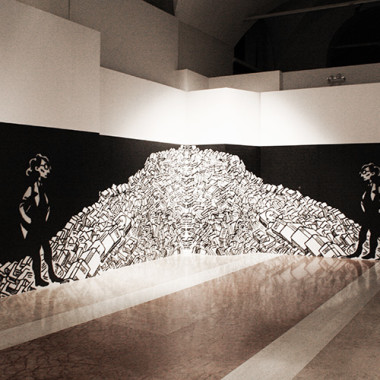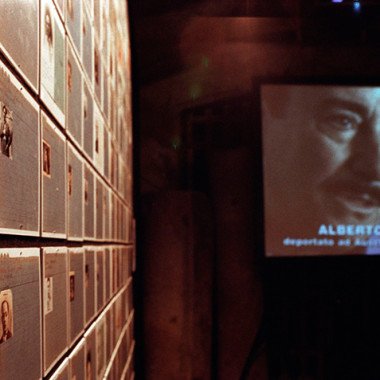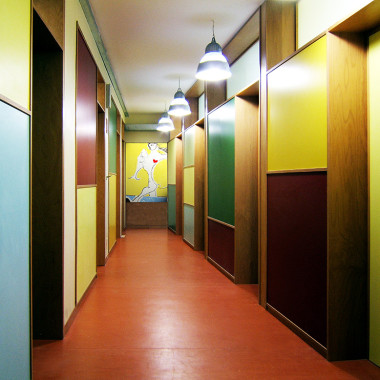-
Mostra Shoah, Vittoriano degli Italiani, Roma
Francesco Collotti con Giacomo Pirazzoli e fotografie di Marco Vacca
Roma, 2004-2005Allestimento della mostra Dalle leggi antiebraiche alla Shoah, sette anni di storia italiana 1938-1945 – Roma, Vittoriano degli Italiani
L’allestimento è un muro che – alla maniera di una vertebra – si insedia nella parte centrale degli spazi scavati nel basamento del Vittoriano.
In muro, fatto fisico solido e costruito del quale si coglie lo spessore nella massa in corrispondenza delle nicchie che custodiscono i documenti o laddove il percorso narrativo esige un traguardo – una finestra – che lasci cogliere altre parti della mostra.
Il muro – tutt’altro che provvisorio – è realizzato con questo strano OSB, materiale riciclato fatto di scarti di legno, trattato con una scialbatura di minio. Sul pavimento è un lastricato di lamiere d’acciaio relativamente pesanti, ritrovato selciato capace di radicare ancora di più il muro alla terra.
Nel luogo centrale del Vittoriano, all’intersezione tra il suo asse longitudinale di simmetria e l’asse trasversale individuato dal muro, in un parallelepipedo di metallo e perspex è esposto il testo delle leggi antiebraiche firmate da Mussolini e dal re e che furono l’atto che aprì la strada anche in Italia, dopo l’occupazione nazista, alla Shoah; da questo luogo del cominciamento – lungo l’asse del Vittoriano – si traguarda a mezzo di una finestra aperta lo spazio di Auschwitz.
Origine e destino della drammatica vicenda degli ebrei italiani dal 1938 al 1945 sono visivamente collegati.
La mostra, inaugurata nel giorno anniversario della razzia del ghetto di Roma e conclusa nel giorno della memoria 2005, è stata promossa da Fondazione Centro Documentazione Ebraica Contemporanea (Milano) e patrocinata dalla Presidenza della Repubblica.
-
Holocaust Exhibition, Vittoriano degli Italiani, Rome
Francesco Collotti with Giacomo Pirazzoli and Photography by Marco Vacca,
Rome, 2004-2005The exhibiton From the anti-Jewish laws to the Holocaust, seven years of Italian History 1938-1945 – Roma, Vittoriano degli Italiani. The exhibition structure is a wall, evoking a vertebra, which is installed in the centre of the excavated space in the Vittoriano building. A wall, a solid, physical mass from which you feel the depth of the niches which house the documents or where the narrative arrives at an objective –a window- which opens up other parts of the exhibition. The wall –anything but temporary- is made of OSB, recycled wood flakes treated with synthetic resin. The flooring is in heavy steel plates able to root the wall further into the ground. In the centre of the Vittoriano, at the intersection of the longitudinal and transversal axis indicated by the wall, in a parallelepiped of metal and perspex, the text of the anti-Jewish laws signed by Mussolini and the King are displayed here. These laws opened the road in Italy, after the Nazi occupation, to the Holocaust. From this point of reference you can see through an open window into Auschwitz. The origin and destiny of this dramatic story of Italian Jews between 1938 and 1945 are visibly linked here. The exhibition, which opened on the anniversary of the raid on the Jewish Quarter in Rome and closed on Remembrance Day in 2005, was sponsored by the Foundation for the Contemporary Jewish Documentation Centre in Milan (Fondazione Centro Documentazione Ebraica Contemporanea ,Milano) and patronized by the Presidency of the Republic.

